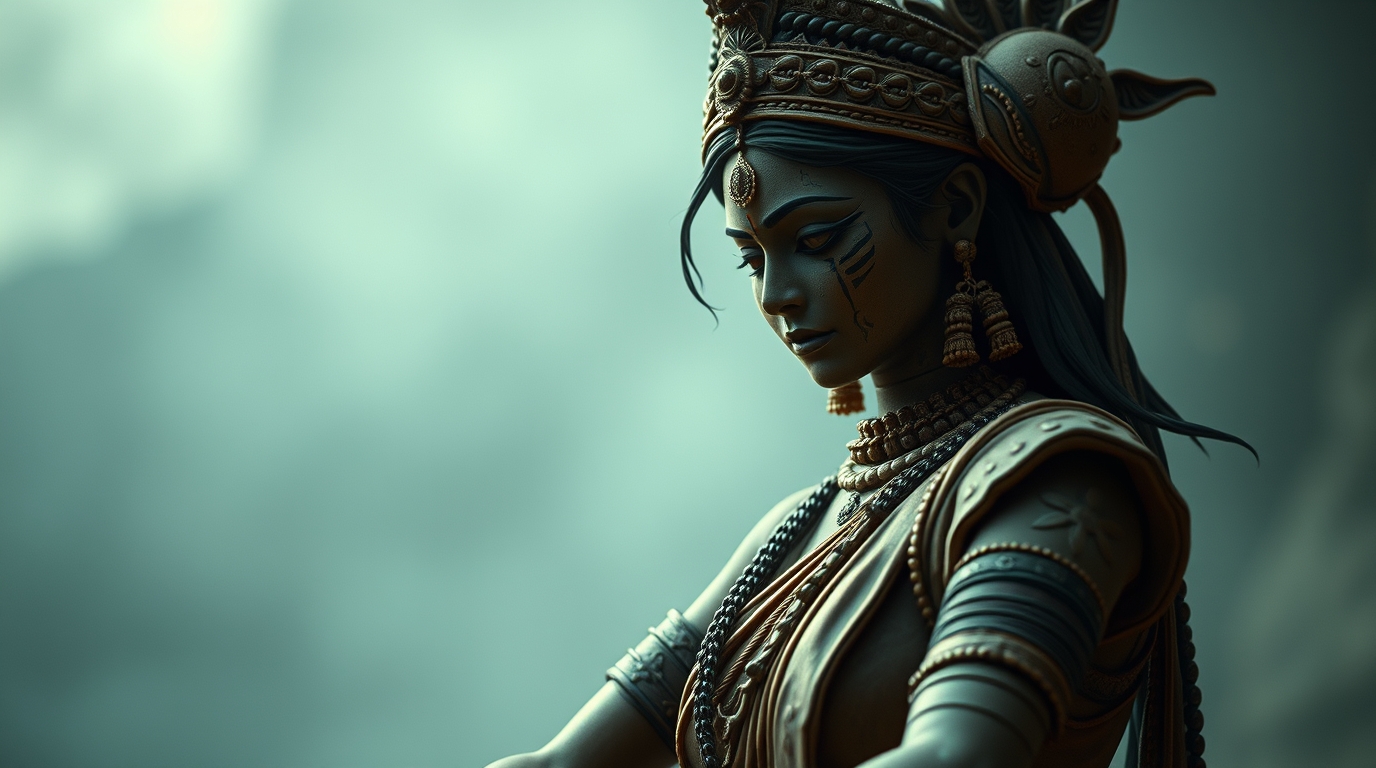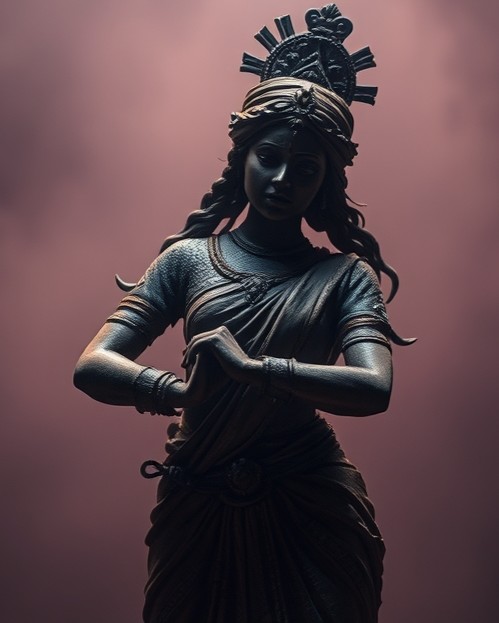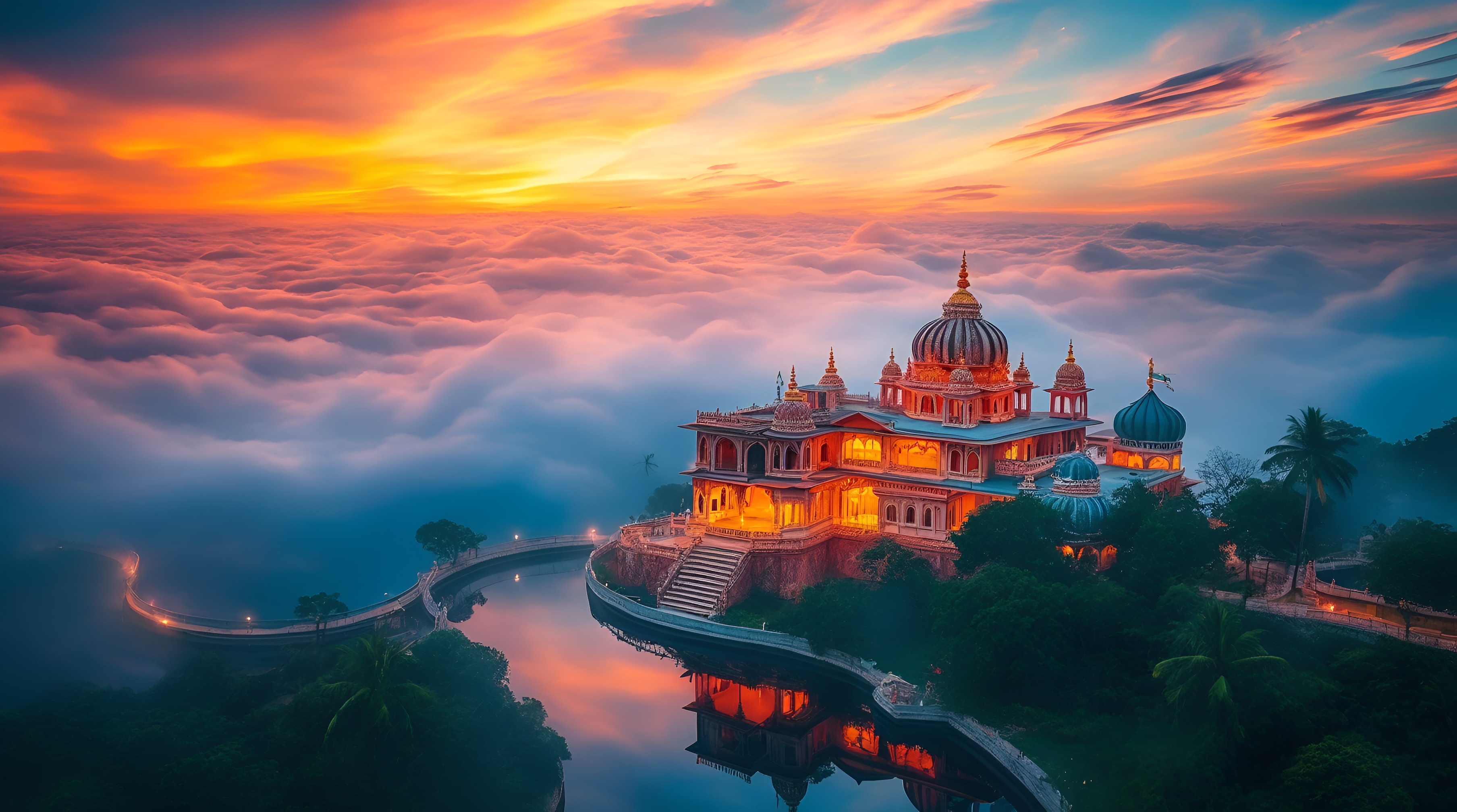“Perfection lies not in a single extreme, but in the eternal dialogue between form and freedom, law and mercy—an ongoing dance that anchors the cosmos.”— Anonymous
You arrive in Kaladesh.
Here the mysteries of reality feel tangible, woven into every structure and flowing through every breeze.
Kaladesh is a realm where the principles of cosmic order and infinite compassion intertwine. Every element of Kaladesh reflects its divine rulers, Purna and Aarav, who balance precision and grace with the fluidity of life.
Kaladesh rests atop towering peaks, with vast temples and lush gardens emerging from a sea of ever-shifting clouds, glowing brightly under the golden light of the high sun.
Silvery-blue rivers flow through the realm, tracing intricate patterns like the veins of a living organism. These waters are the lifeblood of Kaladesh, flowing from Aarav's pure heart, bringing renewal and clarity to those who approach.

Intention and Artistry
Reflective pools surround impressive temples and palaces, their walls plastered smooth in Kaladesh's signature hue of warm terracotta clay and adorned with intricate paintings of lotus flowers, celestial patterns, and sacred deities. Countless domes made from copper and bronze rise through the clouds to catch the light, radiating of abundance across the land.
Perpetually perched atop gleaming, skybound peaks, the realm exists as a grand convergence point of agriculture, medicine, and law. Vast terraces and lush fields supply rare medicinal herbs and crops used throughout all realms. Sacred clinics and healing springs, guided by Aarav’s tender nature, mend afflictions of body and spirit. Courtyards and halls where cosmic precepts are codified and balanced, anchored by Purna’s devotion to justice and structure.
The high terraces of Kaladesh are engineering marvels, each carved into the soaring mountains and kept aloft partly by mechanical genius, partly by divine will. Water from the silvery-blue rivers is controlled through an artful system of dams and aqueducts, believed to conduct Aarav’s healing energy and make the waters here particularly good to drink. The terraces themselves are lined wi dark, fertile soil where important crops grow in meticulously arranged rows, including medicinal plants so potent that a single leaf can purge sickness or mend a broken spirit.


Compassion of the Seven Rivers
Aarav’s presence is soothing, like a cool breeze on a sweltering day. He moves with an easy grace, his every gesture imbued with kindness. When he speaks, his voice carries a calm strength that washes over others with reassurance and understanding.
He values connection and deeply believes in the potential for good in all beings. While his idealism is one of his greatest strengths, it does not blind him to the harsher realities of existence. In matters of law, he pleads for empathy. In agriculture, he encourages generosity and sharing of surplus. Yet his compassion sometimes verges on naïveté, leaving him open to manipulation by tricksters or the unscrupulous.
Aarav’s skin has the warmth of sunlit bronze. His hair falls in loose waves, dark and glimmering, like water cascading over rocks. His eyes are soft yet penetrating, carrying the depth of an ocean and the kindness of a gentle rain. Around his neck and wrists are strands of translucent beads that sparkle with faint, watery glimmers. His warm eyes and unguarded posture make him approachable to the meek, the weary, and the sorrowful. Where Purna emanates structured grace, Aarav radiates comforting fluidity.

Subtle BACKGROUND COLOR
Lorem ipsum dolor sit amet, consectetur adipiscing elit. Proin sodales nulla ut quam efficitur, in pharetra magna cursus.


The Forge of Order
Purna’s terracotta skin radiates a subdued ember-like glow. The ornaments in her hair—bronze lotuses with precise petals—testify to her devotion to structure and beauty and honor her story. She wears layers of gold and jade jewelry, their designs precise and symmetrical. Her features are regal yet serene, with high cheekbones and eyes that seem to reflect the steady march of time itself.
Purna’s presence is commanding yet calming, like the stillness of a temple before dawn. Her countenance is tranquil, but there’s an unspoken certainty in her gaze. She radiates a sense of unshakable purpose, her very breath seeming to align the chaos around her into harmony. When she moves, it is with deliberate precision, as if each step is part of a divine dance. .
As the goddess of order, grace, and beauty, Purna’s role is to maintain balance in her realm and beyond. She ensures that the cycles of nature are synchronized, and she is who is said to help life continue on after disaster strikes. Her touch can restore broken things, from shattered artifacts to fragmented souls. However, her adherence to structure can sometimes make her inflexible, and she struggles with the unpredictability of emotions or chaos, something that Aarav is well-equipped to help with. .
Purna is dignified and resolute, with a quiet strength that inspires reverence. While she is deeply empathetic, she often hides her vulnerabilities behind a mask of perfection. Purna’s calm authority can quell chaos, but her fear of unpredictability makes her rigid at times. Her greatest fear is losing the balance she has worked so hard to maintain.
In the Era of Swirling Chaos
Long before stars found their courses or rivers had names, the universe was a great maelstrom of formless potential. Seas of molten possibility coiled within fathomless voids, and shapes would appear and vanish in the blink of a cosmic eye—echoes of realities that never came to be.
In those days, the roiling chaos birthed countless monstrous forms: some roared with the voices of collapsing galaxies, others stretched their limbs to swallow entire spacetimes. Yet this pandemonium lacked any guiding principle—no anchor to chain the endless swirling into an intelligible cosmos.
Amid the shapeless churn, one small yet radiant spark glimmered in the dark. Legends say it was a leftover fragment from the **First Word** spoken by a being so ancient that even the chaos had forgotten its name. Drawn to it, the chaos surged around the spark like hungry shadows, trying to engulf it.
But the spark would not be consumed. Instead, it sank slowly through the swirling madness, illuminating a hidden realm of cosmic clay—a womb of primordial mud nestled deep in the universe’s belly. This mud was rich in unrealized potential, tinted red-gold by ephemeral embers of cosmic fire. The spark burned a circular path through the clay, forming a terracotta heart in its wake.
It is said that no mortal eye has ever beheld the force that shaped the clay, yet ancient epics call it the Sculpting Hand—an unseen, impossible entity that emerged only once to forge the first principle of order. With motions too swift to track, the Sculpting Hand gathered the terracotta heart, tempered it with cosmic stardust, and formed a harmonious being.
Where the heart pulsed, a gentle warmth glowed beneath the being's terracotta skin. Lotus motifs were etched across its limbs, each petal representing a law of existence—time, rhythm, growth, decay, synergy, repose, and renewal. When the Sculpting Hand was done, Purna opened her eyes to the swirling chaos and came into being—alone.
At the moment she first drew breath, an unearthly lotus made of spiraling bronze petals unfolded behind her. Its hum echoed through the void in pure, resonant tones, a melody of universal alignment. The monstrous beings of chaos recoiled, for the first time feeling the weight of an unbreakable order pressing upon their unbridled freedom.
Dance of the Cosmic Wheel
From the moment Purna stood, the swirling chaos tested her will. Seven cataclysmic trials beset her, each unleashed by the primeval forces that rejected the newly forming principle of structure. By the end of these seven trials, the chaotic cosmos had begun to realign around her calm, resolute presence. No monstrous being dared challenge her command of universal rhythms.
With chaos subdued, Purna reached into the swirling remains of the final time loop and drew out a cosmic wheel etched with sacred geometry—the blueprint for balanced creation. She spun this wheel in her hands, and as it turned, the concept of cosmic law took root across every corner of reality.
Exhausted but unbroken, Purna performed a silent dance, each step reverberating through the cosmos. Where her foot touched the vast emptiness, a new form of order blossomed—seasons, harvest cycles, the symmetry of living organisms, the moral equilibrium of souls. Some legends claim this dance still echoes in every fractal pattern of nature, from the swirl of galaxies to the veins in a leaf.
Thus was crowned the goddess of order, grace, and beauty, destined to maintain balance not only in her realm but in the hearts of mortal and immortal alike. In her terracotta skin glows the memory of that primordial forge, a gentle ember reminding all that order, in its purest form, nurtures life rather than smothering it.


Cosmic Choreography
Long ago, Purna’s seven-step Dance of the Cosmic Wheel was said to etch the laws of the universe into the swirling chaos, laying down a framework for time, growth, form, and even consciousness. The dance has been passed down for as long as anyone can remember, blossoming into myriad forms.
In the high temples, the dance is performed with methodical reverence all day and night without stopping. These dancers are rarely seen and only spoken of in hushed tones, believed by the devout to be the sacred catalysts that maintain cosmic order on Purna's behalf.
A more accessible version of the dance is traditionally performed in celebrations like weddings, birthdays, and harvest festivals, with less emphasis on precision and more of a focus on community.
The dance of the Natyadevi, however, is by far the most impressive—and most feared.

Purna's Wall of Dancers
The Natyadevi are both the priestesses who safeguard Purna’s cosmic choreographies and the high-ranking dancers who stand guard over Kaladesh in times of need. Much like an army, they are well-organized and highly trained—but instead of swords and shields, they wield the divine artistry of dance and ritual.
From the moment they begin training, each Natyadevi masters more than just dance steps—they learn how to harness the Sacred Balance, channeling cosmic energies through precise motions of their body. Although typically peaceful, they maintain a readiness to intervene whenever chaotic forces threaten the realm—be these supernatural entities, environmental imbalances, or moral corruption festering.
The Natyadevi rarely engage in lethal combat. Their style emphasizes disabling or neutralizing an enemy rather than destroying them. If a horde of marauders stormed Kaladesh, the dancers would use illusions and earth-binding spins to stop the threat before a sword is ever drawn.
Young women across Kaladesh dream of joining their ranks not just for prestige but because they believe it’s the purest way to serve the goddess of universal law, and many others yearn to serve Purna by devoting themselves to her chosen daughters.
Their ranks stand as a testament to Purna’s teaching: that true strength is not brute force, but disciplined, measured grace. In every spin and every synchronized step, they uphold the laws that shape existence itself—proof that sometimes, art and war can be two sides of the same cosmic coin.
